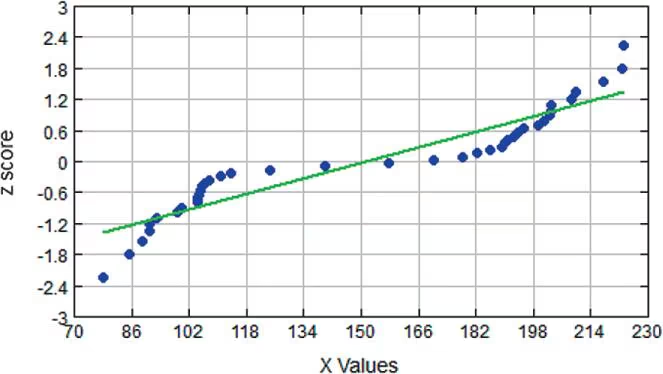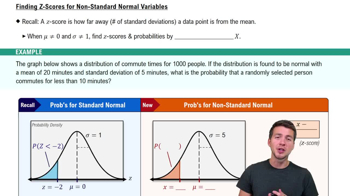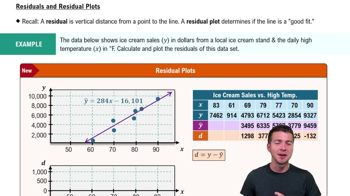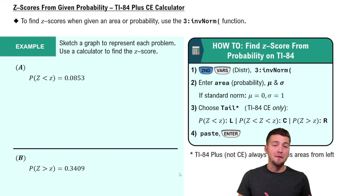Standard Normal Distribution. In Exercises 9–12, find the area of the shaded region. The graph depicts the standard normal distribution of bone density scores with mean 0 and standard deviation 1.
Table of contents
- 1. Intro to Stats and Collecting Data1h 14m
- 2. Describing Data with Tables and Graphs1h 55m
- 3. Describing Data Numerically2h 5m
- 4. Probability2h 16m
- 5. Binomial Distribution & Discrete Random Variables3h 6m
- 6. Normal Distribution and Continuous Random Variables2h 11m
- 7. Sampling Distributions & Confidence Intervals: Mean3h 23m
- Sampling Distribution of the Sample Mean and Central Limit Theorem19m
- Distribution of Sample Mean - Excel23m
- Introduction to Confidence Intervals15m
- Confidence Intervals for Population Mean1h 18m
- Determining the Minimum Sample Size Required12m
- Finding Probabilities and T Critical Values - Excel28m
- Confidence Intervals for Population Means - Excel25m
- 8. Sampling Distributions & Confidence Intervals: Proportion1h 12m
- 9. Hypothesis Testing for One Sample3h 29m
- 10. Hypothesis Testing for Two Samples4h 50m
- Two Proportions1h 13m
- Two Proportions Hypothesis Test - Excel28m
- Two Means - Unknown, Unequal Variance1h 3m
- Two Means - Unknown Variances Hypothesis Test - Excel12m
- Two Means - Unknown, Equal Variance15m
- Two Means - Unknown, Equal Variances Hypothesis Test - Excel9m
- Two Means - Known Variance12m
- Two Means - Sigma Known Hypothesis Test - Excel21m
- Two Means - Matched Pairs (Dependent Samples)42m
- Matched Pairs Hypothesis Test - Excel12m
- 11. Correlation1h 6m
- 12. Regression1h 50m
- 13. Chi-Square Tests & Goodness of Fit1h 57m
- 14. ANOVA1h 57m
6. Normal Distribution and Continuous Random Variables
Standard Normal Distribution
Problem 2.2.19d
Textbook Question
Interpreting Normal Quantile Plots Which of the following normal quantile plots appear to represent data from a population having a normal distribution? Explain.

 Verified step by step guidance
Verified step by step guidance1
Step 1: Understand the purpose of a normal quantile plot. A normal quantile plot is used to assess whether a dataset follows a normal distribution. If the data is normally distributed, the points in the plot will approximately form a straight line.
Step 2: Observe the plot provided. The x-axis represents the data values (X Values), and the y-axis represents the corresponding z-scores (standardized values). The green line represents the expected linear relationship if the data is normally distributed.
Step 3: Analyze the alignment of the data points with the green line. If the points closely follow the green line with minimal deviation, this suggests the data is likely from a population with a normal distribution. Significant deviations or curvature would indicate non-normality.
Step 4: Note any patterns or deviations. In the provided plot, the points generally follow the green line, but there are slight deviations at the lower and upper ends. These deviations could indicate minor departures from normality, but overall, the data appears reasonably linear.
Step 5: Conclude based on the analysis. Since the majority of the points align well with the green line, the plot suggests that the data is likely from a population having a normal distribution, with minor deviations that may not significantly affect the overall normality.
 Verified video answer for a similar problem:
Verified video answer for a similar problem:This video solution was recommended by our tutors as helpful for the problem above
Video duration:
1mPlay a video:
Was this helpful?
Key Concepts
Here are the essential concepts you must grasp in order to answer the question correctly.
Normal Distribution
A normal distribution is a continuous probability distribution characterized by its bell-shaped curve, where most of the observations cluster around the central peak and probabilities for values further away from the mean taper off symmetrically. It is defined by two parameters: the mean (average) and the standard deviation (spread). Understanding this concept is crucial for interpreting data that is expected to follow this pattern.
Recommended video:
Guided course

Finding Z-Scores for Non-Standard Normal Variables
Quantile Plot
A quantile plot, specifically a normal quantile plot, is a graphical tool used to assess if a dataset follows a normal distribution. It plots the quantiles of the data against the quantiles of a normal distribution. If the points in the plot closely follow a straight line, it suggests that the data is normally distributed, while deviations from this line indicate departures from normality.
Recommended video:
Guided course

Residuals and Residual Plots
Z-scores
A Z-score represents the number of standard deviations a data point is from the mean of the dataset. It is calculated by subtracting the mean from the data point and dividing by the standard deviation. In the context of a normal quantile plot, Z-scores are used to standardize the data, allowing for a direct comparison to the expected values of a normal distribution, which aids in identifying normality.
Recommended video:
Guided course

Z-Scores From Given Probability - TI-84 (CE) Calculator

 9:47m
9:47mWatch next
Master Finding Standard Normal Probabilities using z-Table with a bite sized video explanation from Patrick
Start learningRelated Videos
Related Practice
Textbook Question
